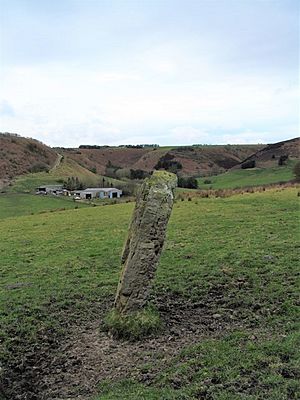Blakey Topping standing stones facts for kids
Quick facts for kids Blakey Topping standing stones |
|
|---|---|

One of the stones
|
|
| Location | North York Moors |
| Lua error in Module:Location_map at line 420: attempt to index field 'wikibase' (a nil value). | |
The Blakey Topping standing stones are an interesting group of ancient stones. You can find them near the Hole of Horcum in the beautiful North York Moors area of England. These stones stand at the bottom of a hill called Blakey Topping.
Contents
What Are Standing Stones?
Standing stones are large stones that people in ancient times placed upright in the ground. They are often found alone or in groups. We don't always know exactly why they were put there. Some might have been used for special ceremonies, to mark important places, or even to track the sun and stars.
The Stones at Blakey Topping
There are at least four standing stones still visible at Blakey Topping today. Some experts think there might have been more in the past.
- The tallest stone is about 1.9 meters (over 6 feet) high. It has been worn down by weather over many years and leans a bit.
- Another stone is about 1.0 meter (just over 3 feet) tall. It looks like its top part might have broken off a long time ago.
- A third stone is 1.3 meters (about 4 feet) high. This one has been shaped roughly into a square. It is currently being used as a gate post, which is a bit unusual for an ancient stone!
- The fourth stone is 1.4 meters (about 4.5 feet) tall. It sits in an old field bank. Like the tallest stone, it is also very weathered and leans to one side.
Some people believe there might be a fifth stone. Also, a few hollow spots in the ground could show where other stones once stood.
What Was Their Purpose?
Historians and archaeologists have different ideas about what these stones were originally for.
Stone Circle Theory
One idea is that the Blakey Topping stones were once part of a stone circle. If this is true, the circle would have been about 17 meters (about 56 feet) wide. Stone circles were often used for important gatherings or religious events in ancient times.
Other Ideas
Another thought is that the stones might have formed a curving line. Or, they could have been set up in two rows that ran parallel to each other. It's a mystery that makes these stones even more interesting!

